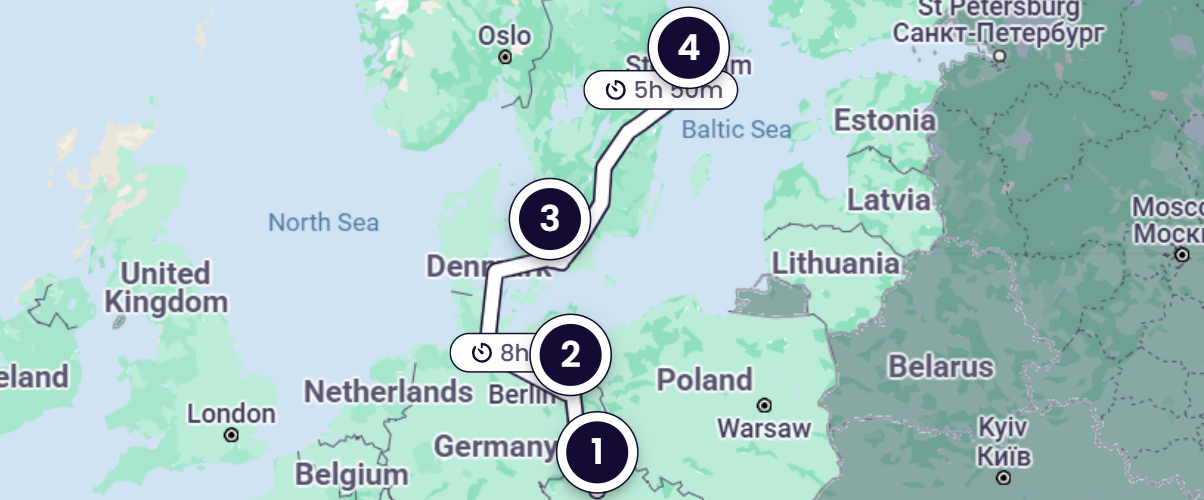Hi guys, and welcome to the second chapter of this series about European Youth!
In the first chapter, I talked about three projects I wanted to share with you – just to break the ice. In this new chapter, we’ll dive into the Interrail experience and how my two friends and I organized it!
Step 1: “Friends”
In my opinion, the more people you bring with you, the better! On the DiscoverEU website, you’ll find all the info you need to make a group application – but you can also plan your trip after winning or buying the ticket.
Can I travel with my friends?
Yes, you can! You can travel solo or add up to 4 friends to your group, as long as they meet the eligibility requirements. They’ll need your application code to submit their own. Check out FAQs B.5 to B.11 for more details.
You can also team up with other DiscoverEU travellers! The DiscoverEU Facebook Group is the perfect place to connect! And if you want to go solo – that’s totally fine too!
Step 2: “Where should I go?”
This is the fun part… but it can also be a bit overwhelming. So how do you choose your destinations?
Here is our trip!

(Czechia, Germany, Denmark, and Sweden)
Here’s where we decided to go – but more importantly, here are some questions to help you shape your own trip:
-
Time frame: How many days will I travel? How long do I want to stay in each city or country? (Don’t forget to factor in train travel time!)
-
Weather: Once you’ve chosen your travel period, think about the climate. A boiling Rome? A freezing Stockholm? A busy Amsterdam in the rain?
Example: If you’re traveling in summer but hate extreme heat, I wouldn’t recommend France or Italy. If you’re going in winter and don’t like the cold, maybe skip Sweden or Norway. -
What do I want to see? Food? Art and culture? Nightlife? Nature? Beaches or mountains?
-
Do I want a strict itinerary or a more relaxed one?
Maybe you want to tour all of Italy – or maybe focus on a specific region like the Balkans, the Iberian Peninsula, or Scandinavia. -
What’s my budget?
Step 3: Bureaucratic stuff
If you’re doing DiscoverEU, make sure you read all your emails – deadlines are crucial! If you have questions, the official info email is really quick and helpful.
If you live in a more remote area, you might be eligible for a free flight to reach your departure point – don’t forget to request it as early as possible.
More info here: DiscoverEU Contact
Step 4: Organize your travel
Once you know your route, use the DiscoverEU app to start building your itinerary.
-
Plan all your train connections.
-
Decide how many days you’ll spend in each city or country.
-
Check if you need to book train seats – especially for high-speed or night trains.
-
If you have free seat reservations included, contact the support team to find out how many and how to book them.
 Step 5: Booking
Step 5: Booking
There are two main things to book before leaving:
1. Accommodation:
-
How far is the place from the city center?
-
Is it reachable by public transport?
-
What type of accommodation do I want? A B&B for more comfort? A hostel? A hotel?
It all depends on your budget and travel style. -
Read the reviews! Just in case.
2. Museums and attractions:
-
With DiscoverEU, you’ll receive a European Youth Card with discounts on museums and other cultural sites.
-
Book in advance! Museums fill up quickly – especially in the summer.
-
If everything’s booked, look online for smaller or alternative museums
Step 6: Backpack or suitcase?
This one’s easy: I truly believe that a backpack – a large one, like for hiking – is the only real option.
This won’t be a chill vacation. You’ll be moving constantly, walking a lot, and carrying your stuff everywhere. So pack only what’s really necessary:
-
Essential clothing (choose versatile outfits for different climates)
-
A camera for tons of pictures and videos
-
Documents: passport, ID, digital copies, credit card, health card
-
Chargers, universal adapter, power bank, headphones
-
Lock, towel, sleep mask, earplugs
Step 7: Tips and Tricks
-
Plan, but leave room for spontaneity
Create a basic itinerary (with key stops and train routes), but don’t overbook your days. -
Be careful with reservations
Some trains require mandatory reservations (especially high-speed and night trains). Check on the Interrail app, and book in advance if needed. If not, look for slower regional trains – they’re free with your pass. -
Download the Interrail app, but double-check
It helps with schedules and bookings, but some trains aren’t listed. Always cross-check with local railway websites. -
Hostels are not a downgrade
They’re usually central, affordable, and great for meeting other travellers. If you want peace of mind, book at least the first night in each city. -
Pack light – seriously
Every gram counts. Take just the essentials. If you need anything else, you can buy it on the road. -
Go picnic mode
Shopping at local supermarkets (bread, fruit, hummus, cheese, etc.) saves money and helps you live like a local. Bring a spork and a reusable water bottle. -
Night trains are gold – if you use them well
You save a night’s accommodation and travel long distances. But book early and bring earplugs and a mask. -
Learn a few local words
Even just “hello”, “thank you” or “excuse me” in the local language makes a big difference. -
Sometimes slow trains are better
They take longer, but you see the real Europe: villages, landscapes, people. High-speed trains don’t offer that. -
Be flexible – plans might change
Not everything will go as expected. But often, the best parts of the trip come from unexpected changes.
That’s it!
Thank you for reading this second chapter of the series! We’ll catch up again soon – but remember: the most important thing is to enjoy yourself, experience Europe, discover it, and create as many memories as possible 🙂
Written by
Shape the conversation
Do you have anything to add to this story? Any ideas for interviews or angles we should explore? Let us know if you’d like to write a follow-up, a counterpoint, or share a similar story.






